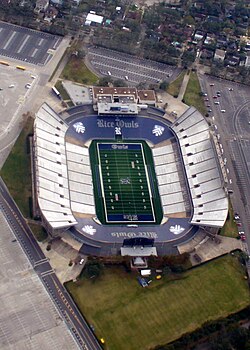
Back Rice Stadium AST Rice Stadium German Rice Stadium Spanish Rice Stadium French 라이스 스타디움 Korean Rice Stadium Dutch Rice Stadium Portuguese Rice Stadium Swedish
 Rice Stadium from the north in 2009, before construction of the Brian Patterson Sports Performance Center | |
Location in the United States Location in Texas | |
| Former names | Houston Stadium |
|---|---|
| Location | 6100 South Main Street Houston, Texas, U.S. |
| Coordinates | 29°42′59″N 95°24′33″W / 29.71639°N 95.40917°W |
| Owner | Rice University |
| Operator | Rice University |
| Capacity | 47,000 (expandable to 59,000)[1] Super Bowl VIII (68,142)[2] |
| Surface | Natural grass (1950–1969) AstroTurf (1970–2005) FieldTurf (2006–2014) AstroTurf GameDay Grass 3D60H (2014–present) |
| Construction | |
| Broke ground | February 1950 |
| Opened | September 30, 1950 |
| Construction cost | $3.295 million ($41.7 million in 2023 dollars[3]) |
| Architect | Hermon Lloyd & W.B. Morgan and Milton McGinty [4] |
| Structural engineer | Walter P Moore[5] |
| General contractor | Brown & Root Constructors |
| Tenants | |
| Rice Owls (NCAA) (1950–present) Houston Cougars (NCAA) (1951–1964) Texas Southern Tigers (NCAA) (1971–2000) Bluebonnet Bowl (1959–1967, 1985, 1986) Houston Oilers (AFL) (1965–1967) Houston Roughnecks (UFL) (2024–present) | |
Rice Stadium is an American football stadium located on the Rice University campus in Houston, Texas. It has been the home of the Rice Owls football team since its completion in 1950,[6] and hosted John F. Kennedy's "We choose to go to the Moon" speech in 1962 and Super Bowl VIII in early 1974.
Architecturally, Rice Stadium is an example of modern architecture, with simple lines and an unadorned, functional design. The lower seating bowl is located below the surrounding ground level. Built solely for football, the stadium has excellent sightlines from almost every seat. To achieve this, the running track was eliminated so that spectators were closer to the action and each side of the upper decks was brought in at a concave angle to provide better sightlines. It is still recognized in many circles as the best stadium in Texas for watching a football game. Entrances and aisles were strategically placed so that the entire stadium could be emptied of spectators in nine minutes.[7]
In 2006, Rice University upgraded the facility by switching from AstroTurf to FieldTurf and adding a modern scoreboard above the north concourse.[8] Seating in the upper deck is in poor condition, which led the university to move home games for which large crowds were expected to nearby NRG Stadium.
High school football games, especially neutral-site playoff games, are frequently played at Rice Stadium. It can also be used as a concert venue.
- ^ "Rice Stadium". Retrieved March 30, 2009.
- ^ "Machine-like Dolphins repeat". Eugene Register-Guard. (regon). Associated Press. January 14, 1974. p. 3B.
- ^ 1634–1699: McCusker, J. J. (1997). How Much Is That in Real Money? A Historical Price Index for Use as a Deflator of Money Values in the Economy of the United States: Addenda et Corrigenda (PDF). American Antiquarian Society. 1700–1799: McCusker, J. J. (1992). How Much Is That in Real Money? A Historical Price Index for Use as a Deflator of Money Values in the Economy of the United States (PDF). American Antiquarian Society. 1800–present: Federal Reserve Bank of Minneapolis. "Consumer Price Index (estimate) 1800–". Retrieved February 29, 2024.
- ^ "AIA 50 Year Award: Rice Stadium". Archived from the original on April 12, 2007. Retrieved October 15, 2010.
- ^ "First Major Sports Facility". Walter P Moore. March 22, 2016. Retrieved October 21, 2017.
- ^ "Rice Stadium -- home of the Bluebonnet Bowl". Lawrence Daily Journal-World. (Kansas). (photo). December 1, 1961. p. 10.
- ^ "Rice Stadium a remarkable gridiron arena of ingenuity - Houston Business Journal". Archived from the original on February 22, 2014.
- ^ "Rice Stadium Renovations". Rice University Athletics. Retrieved February 24, 2007.
© MMXXIII Rich X Search. We shall prevail. All rights reserved. Rich X Search

